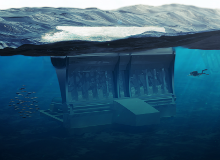

Wave energy is something of a golden apple. It’s a truly sustainable form of energy with, according to research by maritime technology company Fugro Oceanor, an estimated 3.7 terawatts (TW) of potential. This figure is equivalent to 30% of total global energy consumption in 2013. But for a host of technological and economic reasons, this apple remains just out of reach.
Wave generation equipment needs to be robust enough to withstand freak waves, yet light and nimble enough to generate electricity on the calmest of days. And unlike in the case of wind power, which is dependent solely on the speed of the wind, wave conversion technology needs to maintain decent output not just with varying wave heights but varying periods. While many designs have been tried, it is fair to say that nobody yet knows which solution is best.
Harnessing the phenomenon of wave surge
AW-Energy, a Finnish wave power specialist, has been working on a unique solution to these problems since 1993. Now, after many years of testing, modelling and tweaking, the company’s hard work appears to be coming to fruition. Implementation of its technology, known as WaveRoller, has recently received a €10m boost from the European Investment Bank and in July WaveRoller became the first piece of ocean energy technology to be awarded Lloyd’s Register’s Technology Qualification certificate.
WaveRoller is a wave energy converter that is anchored to the seabed in water depths of between 8m and 20m, where the surge of the waves is most powerful. At the same time, it is located near enough to shore to avoid the biggest, harshest waves, which naturally break further out to sea. WaveRoller consists of a composite panel, that flaps back and forth on absorbing energy from the waves. Attached to the panel is a hydraulic piston pump thatpropels hydraulic fluids through a closed circuit contained within a hermetic structure, which seals it off from the marine environment. The hydraulic fluids are fed at high pressure into a motor that drives an electricity generator, and the electrical output is then sent up to the grid via subsea cable.
“The design first occurred to our founder, Rauno Koivusaari, who’s a professional diver, back in 1993,” explains AW-Energy’s chief technology officer Christopher Ridgewell. “He was diving on a shipwreck in the Baltic Sea and he noticed a hatch cover moving back and forth. He tried to stop it with his hand and he couldn’t. He tried to stop it with a piece of wood and it destroyed the wood. He suddenly realised there’s a lot of energy in the surge phenomenon.”
In deep water, the water particles that comprise a wave move in a broad circular motion. But as they approach the shore and start to come into contact with the seabed, this shape becomes squashed into a kind of horizontal, elongated ellipse. This compresses the particles and energises their horizontal movement, creating a strong surge that WaveRoller is situated to absorb. The technology has performed well in testing with the panels, rated at between 500kW and 1,000kW each, demonstrating a capacity factor of between 25%-50%, depending on wave conditions.
Hydraulic fuel helps with consistency conundrum
The company deployed its first test version of WaveRoller in the late 1990s off the coast of Finland, a steel panel, one-by-one metre, that used pumped seawater to power the motor. In 2005 it tried out its first arrays, one at the Marine Energy Centre on Scotland’s Orkney Islands and another near Salinas, Ecuador, to see how Atlantic and Pacific conditions differed. They realised at this point the limitations of using seawater and decided on a switch to hydraulic fluid, a key development in ensuring more consistent power output, whatever the conditions.
“It brought us a lot more control,” says Ridgewell. “We can control the counterforce on the panels better, change the amount of force we are applying to the panel and control the amount of power we are producing to the grid. Loading is quite stochastic – every time you get hit by a wave you peak in pressure, the motors spin and you generate energy. Because it’s very peaky, it’s very difficult to get good compliance from a single device. You could possibly get it from an array but from a single device it’s difficult to get that smooth electricity that the grid requires. So its [hydraulic fluid] helped us get more energy out of the wave and to get smoother electricity to the grid.”
Final test off Portuguese coast
In 2006 the firm tested its first hydraulic-fluid-powered device off the coast of Peniche, Portugal, following up a year after with a 300kW array on which it tested different panel types and power take-off technologies. Now, after more thorough lab testing and strain-gauging, AW Energy is set to deploy its first WaveRoller, a 350kW device, in the same spot off the Portuguese coast.
If that’s successful, there are many parts of the world that Ridgewell thinks would make a good fit. The UK has Feed-in Tariffs for wave-generated electricity and the west coast – which is not conducive to wind energy due to the difficulty of putting up turbines in its choppy wave climate – is a possible target. So is South America, where the cost of electricity is high, and the west coast of the US, where it could prove a better alternative to growing the inland hydropower array, which would require the grid to be expanded at considerable cost.
“In Portugal we are implementing all our new learnings,” Ridgewell says. “Everything we’ve been learning since 1993 into one package. These are technological leaps forward and everything after that is iterative. We just need to demonstrate that these breakthroughs work in the sea as well as in testing. If that’s the case it’s a very straightforward matter of pushing up the power.”



